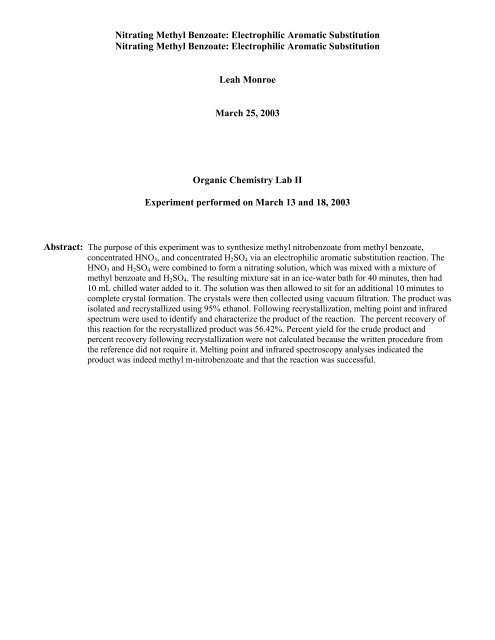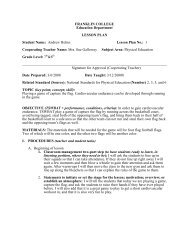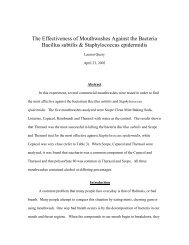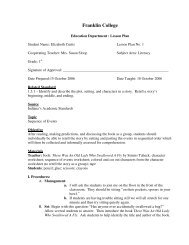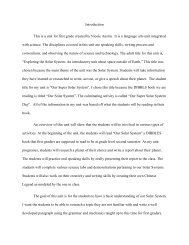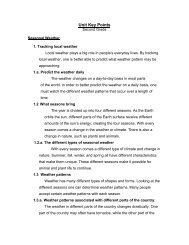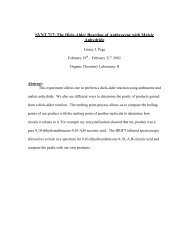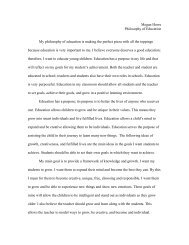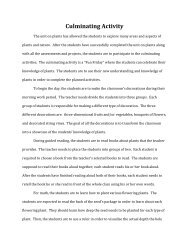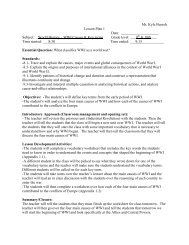Nitrating Methyl Benzoate: Electrophilic Aromatic ... - Franklin College
Nitrating Methyl Benzoate: Electrophilic Aromatic ... - Franklin College
Nitrating Methyl Benzoate: Electrophilic Aromatic ... - Franklin College
Create successful ePaper yourself
Turn your PDF publications into a flip-book with our unique Google optimized e-Paper software.
<strong>Nitrating</strong> <strong>Methyl</strong> <strong>Benzoate</strong>: <strong>Electrophilic</strong> <strong>Aromatic</strong> Substitution<br />
<strong>Nitrating</strong> <strong>Methyl</strong> <strong>Benzoate</strong>: <strong>Electrophilic</strong> <strong>Aromatic</strong> Substitution<br />
Leah Monroe<br />
March 25, 2003<br />
Organic Chemistry Lab II<br />
Experiment performed on March 13 and 18, 2003<br />
Abstract: The purpose of this experiment was to synthesize methyl nitrobenzoate from methyl benzoate,<br />
concentrated HNO3, and concentrated H2SO4 via an electrophilic aromatic substitution reaction. The<br />
HNO3 and H2SO4 were combined to form a nitrating solution, which was mixed with a mixture of<br />
methyl benzoate and H2SO4. The resulting mixture sat in an ice-water bath for 40 minutes, then had<br />
10 mL chilled water added to it. The solution was then allowed to sit for an additional 10 minutes to<br />
complete crystal formation. The crystals were then collected using vacuum filtration. The product was<br />
isolated and recrystallized using 95% ethanol. Following recrystallization, melting point and infrared<br />
spectrum were used to identify and characterize the product of the reaction. The percent recovery of<br />
this reaction for the recrystallized product was 56.42%. Percent yield for the crude product and<br />
percent recovery following recrystallization were not calculated because the written procedure from<br />
the reference did not require it. Melting point and infrared spectroscopy analyses indicated the<br />
product was indeed methyl m-nitrobenzoate and that the reaction was successful.
<strong>Nitrating</strong> <strong>Methyl</strong> <strong>Benzoate</strong>: <strong>Electrophilic</strong> <strong>Aromatic</strong> Substitution<br />
Introduction: The purpose of this experiment is to synthesize methyl nitrobenzoate from methyl benzoate,<br />
concentrated HNO3, and concentrated H2SO4 via an electrophilic aromatic substitution reaction.<br />
The product will then be isolated and recrystallized using 95% ethanol. Following<br />
recrystallization, melting point and infrared spectrum will be used to identify and characterize the<br />
product of the reaction. Regiochemistry of the product will also be determined.<br />
Materials Used:<br />
50-mL beaker 50-mL graduated cylinder<br />
400-mL beaker marking pen<br />
Hirsch funnel with tubing microspatula<br />
25-mL Erlenmeyer flask 3 Pasteur pipets, with latex bulb<br />
125-mL Erlenmeyer flask 3 pipets, 1-mL, with rubber bulb<br />
glass stirring rod sand bath<br />
10-mL graduated cylinder support stand<br />
utility clamp 2 test tubes, 15 x 125-mm<br />
Reagents and Properties:<br />
Substances Formula Weight Quantity<br />
g/mol<br />
Moles Used Mole Ratio Melting Point<br />
°C<br />
Boiling Point Density<br />
°C<br />
<strong>Methyl</strong> benzoate 136.15 0.55 g 4.039 x 10 -3 1 to 1 113 – 115 N/A N/A<br />
<strong>Methyl</strong> nitrobenzoate 181.13 product N/A 1 to 1 78 – 80 N/A N/A<br />
Conc. Nitric acid 63.01 0.5 mL 1.192 x 10 -2 N/A N/A 121 1.5027 g/mL<br />
Conc. sulfuric acid 98.08 1.6 mL 3.0 x 10 -2 N/A N/A N/A 1.841 g/mL<br />
Ethanol, 95% 46.07 2-3 mL N/A N/A N/A N/A N/A<br />
Reaction and its Mechanism:<br />
Overall Reaction:<br />
O<br />
C<br />
<strong>Methyl</strong> benzoate<br />
OCH3<br />
HNO3<br />
H2SO4<br />
NO2<br />
O<br />
C<br />
<strong>Methyl</strong> m-nitrobenzoate<br />
OCH3<br />
+ H2O + H2SO4
Mechanism:<br />
Procedure:<br />
..<br />
O<br />
N<br />
.. H<br />
O<br />
Nitric Acid<br />
O<br />
C<br />
O -<br />
..<br />
..<br />
O N O<br />
+<br />
<strong>Nitrating</strong> <strong>Methyl</strong> <strong>Benzoate</strong>: <strong>Electrophilic</strong> <strong>Aromatic</strong> Substitution<br />
OCH3<br />
+ H O SO3H<br />
Sulfuric Acid<br />
NO2<br />
H<br />
+<br />
- O<br />
O<br />
C<br />
H<br />
OCH3<br />
SO3H<br />
+<br />
H<br />
O<br />
N<br />
O<br />
O -<br />
..<br />
..<br />
- O<br />
N<br />
+<br />
+ SO3H O O<br />
NO2<br />
O<br />
C<br />
<strong>Methyl</strong> m-nitrobenzoate<br />
OCH3<br />
+<br />
H2SO4<br />
+ H2O<br />
Part 1 – Preparing the Ice-Water Bath and Chilled Water<br />
Place equal volumes of ice and tap water into a 400-mL beaker so that the beaker is approximately 75% full. Then,<br />
prepare chilled water for parts three and four of this experiment by pouring approximately 30 mL distilled or<br />
deionized water into a 125-mL Erlenmeyer flask. Place the flask into the ice-water bath.<br />
Part 2 – Preparing the <strong>Nitrating</strong> Solution<br />
Label two 15 x 125-mm test tubes “nitric acid” and “sulfuric acid”, respectively. Transfer 0.5 mL concentrated nitric<br />
acid into the tube labeled “nitric acid.” Then, transfer 0.6 mL concentrated sulfuric acid into the tube labeled “sulfuric<br />
acid”. Chill both the test tubes with the acids in them in the ice-water bath for 15 minutes. Then, use a Pasteur pipet<br />
to very slowly add the cold sulfuric acid drop by drop into the cold nitric acid. Swirl the reaction mixture after every<br />
three drops are added. After adding all the sulfuric acid to the nitric acid, allow the nitrating solution to stand in the<br />
ice-water bath for 10 minutes.<br />
Part 3 – <strong>Nitrating</strong> <strong>Methyl</strong> <strong>Benzoate</strong><br />
Place approximately 0.55 g methyl benzoate into a 25-mL Erlenmeyer flask and add 1.0 mL concentrated sulfuric<br />
acid. Clamp the flask containing the mixture to a support stand. Lower the flask into the ice-water bath for 5 minutes,<br />
being sure to prevent the bath water from entering the reaction flask. After the 5 minutes are up, use a Pasteur pipet to<br />
slowly add the nitrating solution in the test tube to the Erlenmeyer flask containing the methyl benzoate and sulfuric<br />
acid. After all the nitrating solution has been added, allow the mixture to stand in the ice-water bath for 30-45<br />
minutes. Make sure you swirl the flask every 5 minutes. After the 30-45 minutes are up, add 10 mL chilled water to a<br />
50-mL beaker. Slowly and carefully add the cold reaction mixture, with stirring, to the chilled water. Then, allow the<br />
chilled solution to stand 5-10 minutes to complete crystal formation.<br />
Part 4 – Isolating, Purifying, and Characterizing the Product<br />
Filter the reaction mixture via vacuum filtration. Wash the crystals with approximately 10 m L of chilled water in<br />
order to remove any residual acid. Then, allow your product to air dry in the filter tunnel for 10 minutes. Then, put<br />
your product crystals into a 10-mL Erlenmeyer flask and add 1 mL of 95% ethanol. Swirl the flask to mix. Heat the<br />
flask in a sand bath until the crystals are in solution and the solution boils. Boil the solution for a couple minutes, then<br />
remove the flask from the sand bath and allow it to cool to room temperature. Add approximately 0.5 mL ice-cold<br />
ethanol to the flask and swirl to loosen the crystals. Then filter the crystals using vacuum filtration. Allow the product<br />
to dry in the filter funnel for a couple days. Then, weigh your product and record its mass.
<strong>Nitrating</strong> <strong>Methyl</strong> <strong>Benzoate</strong>: <strong>Electrophilic</strong> <strong>Aromatic</strong> Substitution<br />
Part 5 – Melting Points and Infrared Spectrum<br />
Prepare a melting point capillary of the recrystallized product and take its melting point. Also, perform an infrared<br />
spectrum on the recrystallized product. Do this by adding 100 mg KBR to approximately 1mg of the recrystallized<br />
product. Mix the two using a mortar and pestle, being sure to grind the two compounds into a fine powder. Place some<br />
of this mixture in a microcup, making sure the surface is smooth. Then place the pellet in the infrared spectrometer<br />
and obtain an infrared spectrum of the product.<br />
Part 5 – Clean Up<br />
Place all waste materials in their appropriate waste containers.<br />
Data and Calculations:<br />
Mass methyl benzoate used: 0.554 g<br />
Mass recrystallized crystals: 0.413 g<br />
Percent Yield: 56.42%<br />
Melting Point recrystallized product: 77.5 - 80°C<br />
Literature Value: 78 - 80°C<br />
Finding Limiting Reagent<br />
HNO3 (0.5 mL HNO3) (1.5027 g HNO3) (1 mol HNO3) (1 mol methyl nitrobenzoate) (181.3 g methyl nitrobenzoate)<br />
(1 mL HNO3) (63.01 g HNO3) (1 mol HNO3) (1 mol methyl nitrobenzoate)<br />
= 2.159 g methyl nitrobenzoate<br />
H2SO4 (0.6 mL H2SO4) (1.841 g H2SO4) (1 mol H2SO4) (1 mol methyl nitrobenzoate) (181.3 g methyl nitrobenzoate)<br />
(1 mL H2SO4) (98.08 g H2SO4) (1 mol H2SO4) (1 mol methyl nitrobenzoate)<br />
= 2.039 g methyl nitrobenzoate<br />
<strong>Methyl</strong> <strong>Benzoate</strong> (0.554 g methyl benzoate) (1 mol methyl benzoate) (1 mol methyl nitrobenzoate) (181.13 g methyl nitrobenzoate)<br />
(136.15 g methyl benzoate) (1 mol methyl benzoate) (1 mol methyl nitrobenzoate)<br />
= 0.732 g methyl nitrobenzoate<br />
The limiting reagent for this electrophilic aromatic substitution reaction is methyl benzoate. It yields the least amount of<br />
methyl nitrobenzoate in this reaction, and therefore is the limiting reagent.<br />
Theoretical Yield<br />
(0.554 g methyl benzoate) (1 mol methyl benzoate) (1 mol methyl nitrobenzoate) (181.13 g methyl nitrobenzoate)<br />
(136.15 g methyl benzoate) (1 mol methyl benzoate) (1 mol methyl nitrobenzoate)<br />
= 0.732 g methyl nitrobenzoate<br />
Percent Yield<br />
For recrystallized product (mass of recrystallized methyl nitrobenzoate) (0.413 g methyl nitrobenzoate) x (100) =<br />
(theoretical yield) (0.732 g methyl nitrobenzoate)<br />
=56.42% yield
<strong>Nitrating</strong> <strong>Methyl</strong> <strong>Benzoate</strong>: <strong>Electrophilic</strong> <strong>Aromatic</strong> Substitution<br />
Observed Properties and IR Data and Interpretation:<br />
An infrared spectrum of the recrystallized product revealed that it was methyl m-nitrobenzoate. The peak located at<br />
1534.48 cm -1 indicates the presence of an –NO2 group. The peak located at 1734.33 cm -1 is the result of a carbonyl<br />
group and the peak at 1584.9 cm -1 indicates the presence of a benzene ring. Also, the peak at 1076.30 cm -1 indicates a<br />
C—O bond, which is present in methyl m-nitrobenzoate. Regarding the regiochemistry of the obtained product, the<br />
peak at 823.14 cm -1 indicated that the product was a meta-substituted benzene, as was predicted. All these peaks<br />
together indicate that the product was methyl m-nitrobenzoate.<br />
Results and Conclusions:<br />
The electrophilic aromatic substitution reaction between methyl benzoate and a nitrating solution of sulfuric and nitric<br />
acids was successful and yielded methyl m-nitrobenzoate. The percent yield of the recrystallized product was 56.42%.<br />
Percent yield of the crude product was not calculated because the experiment did not include this step and consequently,<br />
percent recovery for the recrystallized product cannot be calculated either.<br />
The melting point of the recrystallized product was 77.5 - 80°C. This was then compared with a data table given in the<br />
experiment in order to determine the regiochemistry of the obtained product. The observed melting point was extremely<br />
close to the literature value of 78 - 80°C for the meta-substituted product. Therefore, analysis of the melting point<br />
determined that the product was methyl meta-nitrobenzoate, as could be predicted. Since –CO2H3 is a strongly<br />
deactivating group, it is meta-directing. Thus, we expected the –NO2 group to be added to the methyl benzoate at the<br />
meta position. The melting point analysis proved that this is what happened and the product obtained was methyl mnitrobenzoate.<br />
An infrared spectrum of the product also confirmed its identity as methyl m-nitrobenzoate. A peak located at 1534.48<br />
cm -1 indicated the presence of an –NO2 group. The peak located at 1734.33 cm -1 was the result of a carbonyl group and<br />
the peak at 1584.9 cm -1 indicated the presence of a benzene ring. Another peak at 1076.30 cm -1 indicated a C—O bond,<br />
which is present in methyl m-nitrobenzoate. Regarding the regiochemistry of the obtained product, the peak at 823.14<br />
cm -1 indicated that the product was a meta-substituted benzene, as was predicted. All these peaks together indicated that<br />
the product was methyl m-nitrobenzoate.<br />
Reference:<br />
Chemistry Lab Experiments CHEM 224 REAC 716 pgs. 61 – 71<br />
By Wigal/Manion/LeFevre/Wade, Jr./Rapp/Lee/Wikholm<br />
Weast, Robert C., ed. CRC Handbook of Chemistry and Physics. 70 th ed. Boca Raton, FL: CRC Press, Inc., 1990.<br />
Post-Lab Questions:<br />
1. (a) The percent yield of my product was 56.42%. See Data section for calculation.<br />
(b) The melting point of my product was 77.5 - 80°C.<br />
(c) The observed melting point of 77.5 - 80°C was most closely related to the literature melting point of 78 –<br />
80°C for a meta substitututed product. Therefore, my product has a meta- regiochemistry. The meta-<br />
product forms because the ortho- and para- products both have very unstable resonance forms with 2<br />
positive charges next to each other. The two positive charges right next to one another cause the<br />
resonance forms to be unstable, so ortho- and para- substituted products do not form in this reaction. The<br />
meta- position is electron-rich, and thus reacts best with the –NO2 group to form methyl m-nitrobenzoate.<br />
Also, we knew the meta- product was going to form because –CO2H3 is a strongly deactivating group and<br />
is meta-directing. Thus, we expected the –NO2 group to be added to the methyl benzoate at the meta<br />
position. This was confirmed by analyzing the melting point.
<strong>Nitrating</strong> <strong>Methyl</strong> <strong>Benzoate</strong>: <strong>Electrophilic</strong> <strong>Aromatic</strong> Substitution<br />
(d) The structure of my product is:<br />
O<br />
NO2<br />
C<br />
<strong>Methyl</strong> m-nitrobenzoate<br />
OCH3<br />
2. The resonance forms for the arenium ion formed during this reaction are as follows:<br />
O<br />
C<br />
+<br />
OCH3<br />
NO2<br />
+<br />
O<br />
C<br />
OCH3<br />
NO2<br />
<strong>Methyl</strong> m-nitrobenzoate<br />
OCH3<br />
3. The first nitration proceeds much faster than the second two because the first –NO2 group to be added is<br />
added to the isolated toluene. The methyl group on the benzene ring is an activating group. It causes the<br />
benzene ring to be more electron rich and thus, have a high reactivity. –CH3 is an ortho-para activator. So,<br />
the first –NO2 group adds to the toluene in the para-position in order to avoid steric crowding from the<br />
methyl group. The toluene has now been converted to para- nitrotoluene. The –NO2 group that is now on<br />
the benzene ring is a deactivating group, and causes the benzene ring to be not nearly as reactive as it was<br />
before the first –NO2 group was added. Thus, the second and third nitrations occur much more slowly<br />
than does the first one.<br />
O<br />
C<br />
+<br />
NO2


